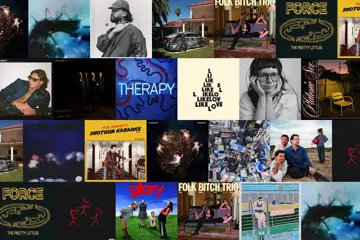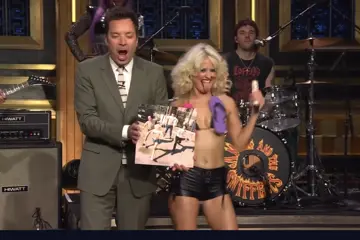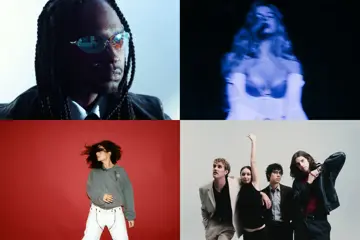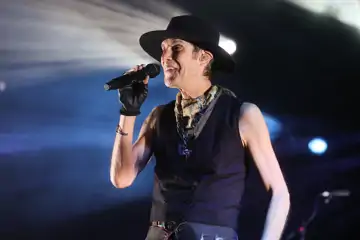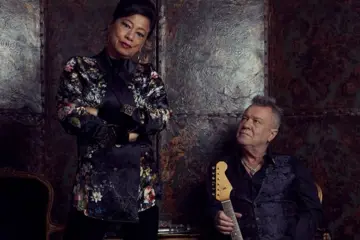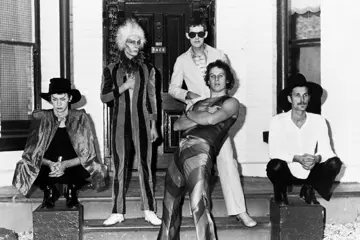 Olivia Newton-John
Olivia Newton-JohnChapter 8
Let’s Get Physical
‘Newton-John thrusted into the ’80s (literally) with her steamy workout anthem ‘Physical’ [and its] music video’s homosexual innuendoes.
Triggered by her Grease character’s transformation from sweet to sexy, Newton-John used the movie’s momentum to change her own image’.
Olivia has been unmasked here as a genius navigator of change.
She adapted to new sounds and styles with the professional skill of a showbiz natural. She effortlessly evolved musically, never abandoning what she moved past, but internalising them all and building on her overall persona and presentation to the public.
As an entertainer of many facets who played the game, the heady days of 1981 saw Olivia receive one of the most significant stamps of celebrity approval – her star on the Hollywood Walk of Fame. 1981 was also
the year she officially became an Australian citizen, with her overdue application expedited by then Prime Minister Malcolm Fraser.
In Australia in 1981, important things were afoot. Funnel-web spider anti-venom was developed. The South Australian Parliament passed the Pitjantjatjara Land Rights Act. The police re-opened the investigation into the missing baby case of Azaria Chamberlain, and Peter
Carey’s novel Bliss won the Miles Franklin Award. Two all-time classic Aussie films were released, Puberty Blues and Gallipoli,
Trevor Chappell bowled his infamous cricket underarm delivery against New Zealand at the MCG and Countdown on the ABC, captained by the also infamous and magnificent Ian ‘Molly’ Meldrum, was ruling the music world.
Molly travelled to where the music was happening and brought it back to Australia. He was wild and loose but had an encyclopaedic music knowledge hidden under that signature hat and an interview style that may have been littered with ‘umms’ and ‘ahhs’ but somehow managed to get the guest to relax and quite often spill the beans, such as when John Lennon told him first that he Beatles were breaking up (and he didn’t realise until he went home and listened to the tape).
Countdown was a weekly Australian music television program broadcast from 1974 to 1987 out of Ripponlea, Melbourne. Like MTV (whose first song was the prophetic ‘Video Killed the Radio Star’ by The Buggles), Countdown had a powerful international impact because it was one of the first TV shows in the world to champion the use of music video as a serious taster to overseas and local acts.
Countdown was instrumental in the worldwide success of many major overseas acts such as Madonna, Blondie, ABBA, John Mellencamp, Meat Loaf and Cyndi Lauper. Exposure was everything, and many New Wave acts became household names because of their music videos, such as Duran Duran, XTC, The Specials, Lene Lovich, The Cure, and even the US punk band the Ramones. For Olivia, always at the forefront of musical change – ‘the message seemed to be goodbye cream puff, hello heartbreaker … Olivia became part of the New Wave music movement, her hits after 1981 were aligned with the sound of the times. Olivia’s singles had a synth-pop sound, from ‘Heart Attack’ to ‘Living in Desperate Times’.’
Let’s not forget the rise of Adam Ant and Ant Music, Orchestral Manoeuvres in the Dark with their soundtrack songs on Pretty In Pink, Ultravox, Soft Cell, Depeche Mode and who can forget The Human League with the first truly ‘Emo’ song ever – ‘Don’t You Want Me’ from 1981’s Dare album. Homegrown acts flourished on Countdown, including Our Livvy. She and Molly had a close friendship, and he interviewed Olivia many times all around the world.
‘MTV was the revolution that put the radio star on notice. Our Olivia, as our Molly had taken to calling her, was a natural for the new medium’s lofty photogenic standards. Still, it was some kind of genius that engineered the image change to leotard, legwarmers and saucy smoulder.’
Other Aussie acts, like John Farnham, AC/DC, INXS, John Paul Young, Skyhooks, Marcia Hines, The Angels, Men at Work, Icehouse, Australian Crawl and Mental As Anything were Countdown regulars and their classic songs ensconced in the public minds, thanks to that critical Countdown hour every Sunday night from 6pm.
Into this sonically inventive period to be alive, Olivia Newton-John dropped a bombshell – the single ‘Physical’.
‘Newton-John revamped herself at the dawn of the music-video era. She knew the power of the art form — her Grammy-winning 1982 video album, Olivia Physical, was the Lemonade of its day, inspiring a prime-time network TV event.’
Rod Stewart and Tina Turner initially turned down this song, which became a commercial phenomenon and Olivia’s biggest hit. It was songwriter Steve Kipner, a Bee Gees associate from way back, who co- wrote ‘Physical’ in 1981. Kipner recalled in an interview for Songwriter Universe: ‘Terry and I were writing a song about the physical side of love, rather than the emotional side.’
At this time, Newton-John’s manager was Australian Roger Davies, and they had timed this explosion perfectly – aiming her new look squarely at the MTV age. MTV was up and running and playing music videos 24 hours a day. Everything came together perfectly – a new fashion look, a new hairdo and a seriously naughty song. It was the perfect musical storm and arguably the biggest song of the ’80s.
The beauty of ‘Physical’ was you could listen to it, even watch the clip many times and still not clock what it was about, and it wasn’t exercise.
‘‘Physical’ was the hit which would leave her innocent persona behind like a snakeskin.’
Olivia explained, ‘I just wasn’t in the mood for tender ballads. I wanted peppy stuff because that’s how I’m feeling … Roger Davies was my manager at the time; he played it for me, and I knew it was a very catchy song.’
Later on, after ‘Physical’ had been recorded, Olivia panicked, thinking the song was too rude to release and called her manager, saying: ‘We’ve got to pull this single!’ Davies assured her there was no need to worry – and that, anyway, it was too late. ‘It’s already gone to radio, and it’s running up the charts.’
It was then Olivia’s idea to release the video first, so people would think the song was about exercise rather than sex. ‘Imply and wink and let you, the public, join the dots.’ Of course, the song was about sex, but her plan worked. ‘Physical’ received massive airplay, except in Utah and South Africa, where the song was banned.
In 1981, Olivia released Physical the album (dedicated to her then boyfriend, Matt Lattanzi, whom she married in 1984). It was her most successful studio album and went double platinum.
‘Physical is a cornerstone of early ‘80s pop’.
Years later, Olivia said on her website, ‘I am so proud of this record as it not only allowed me to try new things musically, but it became a part of pop-culture history.’ 9 It was coupled with the iconic picture that adorns the album, which photographer Herb Ritts shot. Ritts would later create a similar image for Madonna’s 1986 True Blue album.
In 2010, Billboard magazine ranked ‘Physical’ as the most popular single ever about sex. This song had many different layers – the confident woman, the gay love-is-love message and the let’s get fit memo.
For the ladies out there, ’it’s a woman taking control of seduction, claiming for herself the tactics usually deployed by men: the flirtation, the dinner, the movie, the horny insistence.’
The original edit of the video showed our 33-year-old Olivia working out in a gym in front of a group of men. In a twist at the end of the story, it was revealed the men were actually gay as they coupled off holding hands. Sadly, the twist caused MTV to cut the ending. ‘Who would have thought the legendary film clip would set the tone for music video aesthetics for decades to come? Or that the sex-positive anthem would still be finding its way into pop songs forty years later?’
The important message of ‘Physical’ was to bring love out into the open for The LGBTQAI+ community and hopefully start to change the landscape forever. ‘Very often, the things that you’re most afraid of are the things that you really need to just go for,’ Dame Olivia Newton-John said in a 2021 interview with Today.
ONJ was not alone in being banned; Duran Duran released the single ‘Girls on Film’ in July 1981. Their highly controversial music video, which was censored for airplay on MTV and banned by BBC, became the band’s first Top 10 hit in the UK, peaking at number 5, and even today, l could sing every word.
The clip was ground-breaking for another reason – Olivia helped usher in the ’80s fitness craze, almost a year before Jane Fonda’s Workout became a worldwide craze.
It’s astonishing what an impact a leotard, leggings and headband designed by Fleur Thiemeyer had. This exercise-themed video was an aerobics anthem. ‘Olivia had become the fitness goddess of the 1980s. Leg warmers and spandex and a short haircut somewhere between Pat Benatar and Princess Di.’
The album and single were so successful that Olivia toured with Physical all over America to sell-out audiences. The longevity of this song was shown by the 2021, 40th anniversary release Physical: Deluxe Edition. Complete with a note from ONJ, which said, ‘It was all about work ethic and being as good as you could possibly be, and better than you can be …
That’s how you get lightning in a bottle … Physical Postscript.’
This song has ‘been covered by everyone from Kylie Minogue (her nearest touchstone), Sophie Ellis-Bextor, and Delta Goodrem. Doja Cat and SZA borrowed, and Dua Lipa interpolated the lyric ‘let’s get physical’ on her 2022 hit ‘Physical’.’
Along the way, Olivia also transformed into the confident performer she dreamed of being as a child. She told Entertainment Weekly, ‘In the old days, I was just too nervous to have a good time. It may not have shown, but leading up to when I went out on stage, it was always very nerve-wracking, now I really enjoy it … Let go and enjoy yourself.’
Sandy #2, the girl from Grease, is definitely in charge right now. ‘Her success was put down to the combination of great business connections – savvy marketing, her production and writing and design team, ‘just that incredible breath of fresh air that she was’.
After reaching the pinnacle of her career with Physical, her next album was 1985’s sultry Soul Kiss. Long-time collaborator John Farrar co-wrote four tracks, and the cover art featured photos of Olivia by famous photographers Helmut Newton and Herb Ritts. All Music editor Joe Viglione found that Soul Kiss ‘seems a bit contrived’ and called ‘the album, as a whole, one of the weaker links in Olivia’s remarkable chain’.
A little-known fact is that in the video Olivia shot for this single, she was pregnant with her daughter Chloe. The album featured Olivia in tight riding pants and boots, holding a crop on the back cover; it was her last risqué album, as she had decided she wanted to take things easier.
Marriage and motherhood were number one on her list. Olivia married her young live-in boyfriend Matt Lattanzi around Christmas 1984 after they had lived together for four years, and the couple enjoyed a fairytale honeymoon in Paris. Love is in the air, and Olivia’s most remarkable work is being planned – a baby!
Excerpt published with permission courtesy of Wilkinson Publishing. Olivia: Grace and Gratitude is available to order wilkinsonpublishing.com.au.

